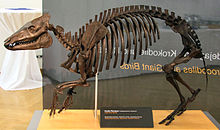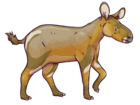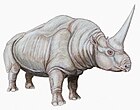Propalaeotherium: Difference between revisions
Junsik1223 (talk | contribs) No edit summary Tags: Mobile edit Mobile web edit |
No edit summary |
||
| (10 intermediate revisions by 8 users not shown) | |||
| Line 8: | Line 8: | ||
| type_species = †'''''Propalaeotherium isselanum''''' |
| type_species = †'''''Propalaeotherium isselanum''''' |
||
| type_species_authority = Cuvier, 1824 |
| type_species_authority = Cuvier, 1824 |
||
| subdivision_ranks = Species<ref name="new">{{cite journal|last1=Remy|first1=Jean A.|last2=Krasovec|first2=Gabriel|last3=Marandat|first3=Bernard|year=2016|title=A new species of Propalaeotherium (Palaeotheriidae, Perissodactyla, Mammalia) from the Middle Eocene locality of Aumelas (Hérault, France)|journal=Palaeovertebrata|volume=40|issue=2|doi=10.18563/pv.40.2.e1}}</ref> |
| subdivision_ranks = Species<ref name="new">{{cite journal|last1=Remy|first1=Jean A.|last2=Krasovec|first2=Gabriel|last3=Marandat|first3=Bernard|year=2016|title=A new species of Propalaeotherium (Palaeotheriidae, Perissodactyla, Mammalia) from the Middle Eocene locality of Aumelas (Hérault, France)|journal=Palaeovertebrata|volume=40|issue=2|pages=e1 |doi=10.18563/pv.40.2.e1}}</ref> |
||
| subdivision = |
| subdivision = |
||
* †''P. argentonicum'' |
* †''P. argentonicum'' <small>Gervais, 1849</small> |
||
* †''P. hassiacum'' |
* †''P. hassiacum'' <small>Haupt, 1925</small> |
||
* †''P. helveticum'' |
* †''P. helveticum'' <small>Savage ''et al.'', 1965</small> |
||
* †''P. isselanum'' |
* †''P. isselanum'' <small>Cuvier, 1824</small> |
||
* †''P. sudrei'' |
* †''P. sudrei'' <small>Remy, Krasovec & Marandat, 2016</small> |
||
* †''P. voigti |
* †''P. voigti'' <small>Matthes, 1977</small> |
||
}} |
}} |
||
'''''Propalaeotherium''''' was an early [[genus]] of perissodactyl [[Endemism|endemic]] to [[Europe]] and [[Asia]] during the [[early Eocene]]. There are currently six recognised species within the genus, with ''P. isselanum'' as the [[type species]] (named by [[Georges Cuvier]] in 1824).<ref name="new" |
'''''Propalaeotherium''''' was an early [[genus]] of perissodactyl [[Endemism|endemic]] to [[Europe]] and [[Asia]] during the [[early Eocene]]. There are currently six recognised species within the genus, with ''P. isselanum'' as the [[type species]] (named by [[Georges Cuvier]] in 1824).<ref name="new" /> |
||
==Taxonomy== |
==Taxonomy== |
||
[[File:Propalaeotherium in Vienna.jpg|thumb|left|Fossil in Vienna.]] |
[[File:Propalaeotherium in Vienna.jpg|thumb|left|Fossil in Vienna.]] |
||
''Propalaeotherium'' was named by [[Paul Gervais]]; its name means "before ''[[Palaeotherium]]''". It was considered a member of Palaeotheriidae by Hooker (1986).<ref>J. J. Hooker. 1986. Mammals from the Bartonian (middle/late Eocene) of the Hampshire Basin, southern England. Bulletin of the British Museum (Natural History) 39(4):191-478</ref> A 2004 study found it to be an equid instead.<ref>{{Cite journal | last1 = Franzen | first1 = J. L. | title = First fossil primates from Eckfeld Maar, Middle Eocene (Eifel, Germany) | doi = 10.1007/s00015-004-1115-8 | journal = Eclogae Geologicae Helvetiae | volume = 97 | issue = 2 | pages = 213–220 | year = 2004 }}</ref> A 2016 study lumped the genus back within the [[Palaeotheriidae]].<ref name="new" |
''Propalaeotherium'' was named by [[Paul Gervais]]; its name means "before ''[[Palaeotherium]]''". It was considered a member of [[Palaeotheriidae]] by Hooker (1986).<ref>J. J. Hooker. 1986. Mammals from the Bartonian (middle/late Eocene) of the Hampshire Basin, southern England. Bulletin of the British Museum (Natural History) 39(4):191-478</ref> A 2004 study found it to be an equid instead.<ref>{{Cite journal | last1 = Franzen | first1 = J. L. | title = First fossil primates from Eckfeld Maar, Middle Eocene (Eifel, Germany) | doi = 10.1007/s00015-004-1115-8 | journal = Eclogae Geologicae Helvetiae | volume = 97 | issue = 2 | pages = 213–220 | year = 2004 | doi-access = free | bibcode = 2004SwJG...97..213F }}</ref> A 2016 study lumped the genus back within the [[Palaeotheriidae]].<ref name="new" /> |
||
The species ''P. parvulum'' and ''P. messelensis'' have been alternately assigned to the equid genus ''[[Eurohippus]]''.<ref>{{Cite journal | last1 = Franzen | first1 = J. L. | doi = 10.1007/BF03043638 | title = Eurohippus n.g., a new genus of horses from the Middle to Late Eocene of Europe | journal = Senckenbergiana Lethaea | volume = 86 | pages = 97–102| year = 2006 }}</ref> |
The species ''P. parvulum'' and ''P. messelensis'' have been alternately assigned to the equid genus ''[[Eurohippus]]''.<ref>{{Cite journal | last1 = Franzen | first1 = J. L. | doi = 10.1007/BF03043638 | title = Eurohippus n.g., a new genus of horses from the Middle to Late Eocene of Europe | journal = Senckenbergiana Lethaea | volume = 86 | pages = 97–102| year = 2006 | s2cid = 84192738 }}</ref> |
||
==Description== |
==Description== |
||
[[Image:Propalaeotherium species.jpg|thumb|''[[Eurohippus]] parvulus'' (on rock) and ''P. hassiacum'' (in water).]] |
[[Image:Propalaeotherium species.jpg|thumb|''[[Eurohippus]] parvulus'' (on rock) and ''P. hassiacum'' (in water).]] |
||
''Propalaeotherium'' was a small animal, ranging from 30–60 cm at the shoulder (2.9 to 5.9 [[Hand (unit)|hands]]), and weighing just {{Convert|10|kg|lb|abbr=on|sigfig=2}}.<ref>S. Legendre. 1988. Les communautes de mammiferes du Paleogene (Eocene superieur et Oligocene) d'Europe occidentale: structure, milieux et evolution. Ph.D. thesis, Universite des Sciences et Techniques du Languedoc, Montpellier, France. 2 volumes. 1-265.</ref> It looked similar to small [[tapirs]]. It had no [[hooves]], but instead several small nail-like hooflets. The well-preserved [[Messel pit|Messel fossils]] showed their [[Herbivore|herbivory]], specifically their preference to eat [[Berry|berries]] and leaf matter picked up from the forest floor.<ref>{{Cite journal | last1 = Wilde | first1 = V. | last2 = Hellmund | first2 = M. | doi = 10.1007/s12549-010-0028-y | title = First record of gut contents from a middle Eocene equid from the Geiseltal near Halle (Saale), Sachsen-Anhalt, Central Germany | journal = Palaeobiodiversity and Palaeoenvironments | volume = 90 | issue = 2 | pages = 153 | year = 2010 }}</ref> |
''Propalaeotherium'' was a small animal, ranging from 30–60 cm at the shoulder (2.9 to 5.9 [[Hand (unit)|hands]]), and weighing just {{Convert|10|kg|lb|abbr=on|sigfig=2}}.<ref>S. Legendre. 1988. Les communautes de mammiferes du Paleogene (Eocene superieur et Oligocene) d'Europe occidentale: structure, milieux et evolution. Ph.D. thesis, Universite des Sciences et Techniques du Languedoc, Montpellier, France. 2 volumes. 1-265.</ref> It looked similar to small [[tapirs]]. It had no [[hooves]], but instead several small nail-like hooflets. The well-preserved [[Messel pit|Messel fossils]] showed their [[Herbivore|herbivory]], specifically their preference to eat [[Berry|berries]] and leaf matter picked up from the forest floor.<ref>{{Cite journal | last1 = Wilde | first1 = V. | last2 = Hellmund | first2 = M. | doi = 10.1007/s12549-010-0028-y | title = First record of gut contents from a middle Eocene equid from the Geiseltal near Halle (Saale), Sachsen-Anhalt, Central Germany | journal = Palaeobiodiversity and Palaeoenvironments | volume = 90 | issue = 2 | pages = 153 | year = 2010 | bibcode = 2010PdPe...90..153W | s2cid = 128890140 }}</ref> |
||
==See also== |
==See also== |
||
| Line 42: | Line 42: | ||
* [http://www.talkorigins.org/faqs/horses/horse_evol.html Horse Evolution] |
* [http://www.talkorigins.org/faqs/horses/horse_evol.html Horse Evolution] |
||
{{Perissodactyla Genera|P.}} |
|||
{{Taxonbar|from=Q133295}} |
{{Taxonbar|from=Q133295}} |
||
[[Category:Palaeotheriidae]] |
|||
[[Category:Eocene horses]] |
[[Category:Eocene horses]] |
||
[[Category:Eocene genus extinctions]] |
[[Category:Eocene genus extinctions]] |
||
Latest revision as of 10:22, 22 October 2024
| Propalaeotherium Temporal range: Ypresian,
| |
|---|---|

| |
| Restored P. hassiacum skeleton | |
| Scientific classification | |
| Domain: | Eukaryota |
| Kingdom: | Animalia |
| Phylum: | Chordata |
| Class: | Mammalia |
| Order: | Perissodactyla |
| Family: | †Palaeotheriidae |
| Genus: | †Propalaeotherium Gervais, 1849 |
| Type species | |
| †Propalaeotherium isselanum Cuvier, 1824
| |
| Species[1] | |
| |
Propalaeotherium was an early genus of perissodactyl endemic to Europe and Asia during the early Eocene. There are currently six recognised species within the genus, with P. isselanum as the type species (named by Georges Cuvier in 1824).[1]
Taxonomy
[edit]
Propalaeotherium was named by Paul Gervais; its name means "before Palaeotherium". It was considered a member of Palaeotheriidae by Hooker (1986).[2] A 2004 study found it to be an equid instead.[3] A 2016 study lumped the genus back within the Palaeotheriidae.[1]
The species P. parvulum and P. messelensis have been alternately assigned to the equid genus Eurohippus.[4]
Description
[edit]
Propalaeotherium was a small animal, ranging from 30–60 cm at the shoulder (2.9 to 5.9 hands), and weighing just 10 kg (22 lb).[5] It looked similar to small tapirs. It had no hooves, but instead several small nail-like hooflets. The well-preserved Messel fossils showed their herbivory, specifically their preference to eat berries and leaf matter picked up from the forest floor.[6]
See also
[edit]References
[edit]- ^ a b c Remy, Jean A.; Krasovec, Gabriel; Marandat, Bernard (2016). "A new species of Propalaeotherium (Palaeotheriidae, Perissodactyla, Mammalia) from the Middle Eocene locality of Aumelas (Hérault, France)". Palaeovertebrata. 40 (2): e1. doi:10.18563/pv.40.2.e1.
- ^ J. J. Hooker. 1986. Mammals from the Bartonian (middle/late Eocene) of the Hampshire Basin, southern England. Bulletin of the British Museum (Natural History) 39(4):191-478
- ^ Franzen, J. L. (2004). "First fossil primates from Eckfeld Maar, Middle Eocene (Eifel, Germany)". Eclogae Geologicae Helvetiae. 97 (2): 213–220. Bibcode:2004SwJG...97..213F. doi:10.1007/s00015-004-1115-8.
- ^ Franzen, J. L. (2006). "Eurohippus n.g., a new genus of horses from the Middle to Late Eocene of Europe". Senckenbergiana Lethaea. 86: 97–102. doi:10.1007/BF03043638. S2CID 84192738.
- ^ S. Legendre. 1988. Les communautes de mammiferes du Paleogene (Eocene superieur et Oligocene) d'Europe occidentale: structure, milieux et evolution. Ph.D. thesis, Universite des Sciences et Techniques du Languedoc, Montpellier, France. 2 volumes. 1-265.
- ^ Wilde, V.; Hellmund, M. (2010). "First record of gut contents from a middle Eocene equid from the Geiseltal near Halle (Saale), Sachsen-Anhalt, Central Germany". Palaeobiodiversity and Palaeoenvironments. 90 (2): 153. Bibcode:2010PdPe...90..153W. doi:10.1007/s12549-010-0028-y. S2CID 128890140.









